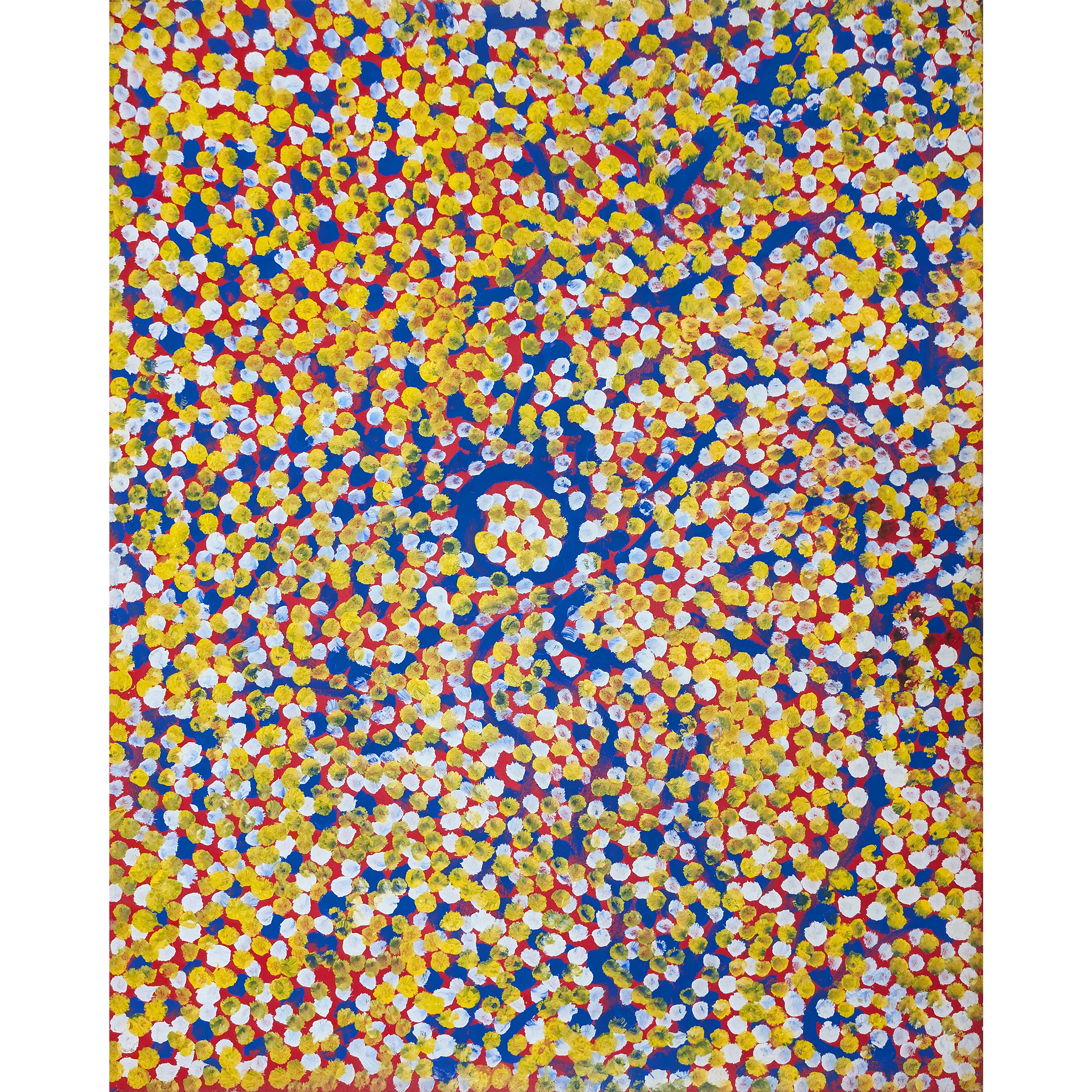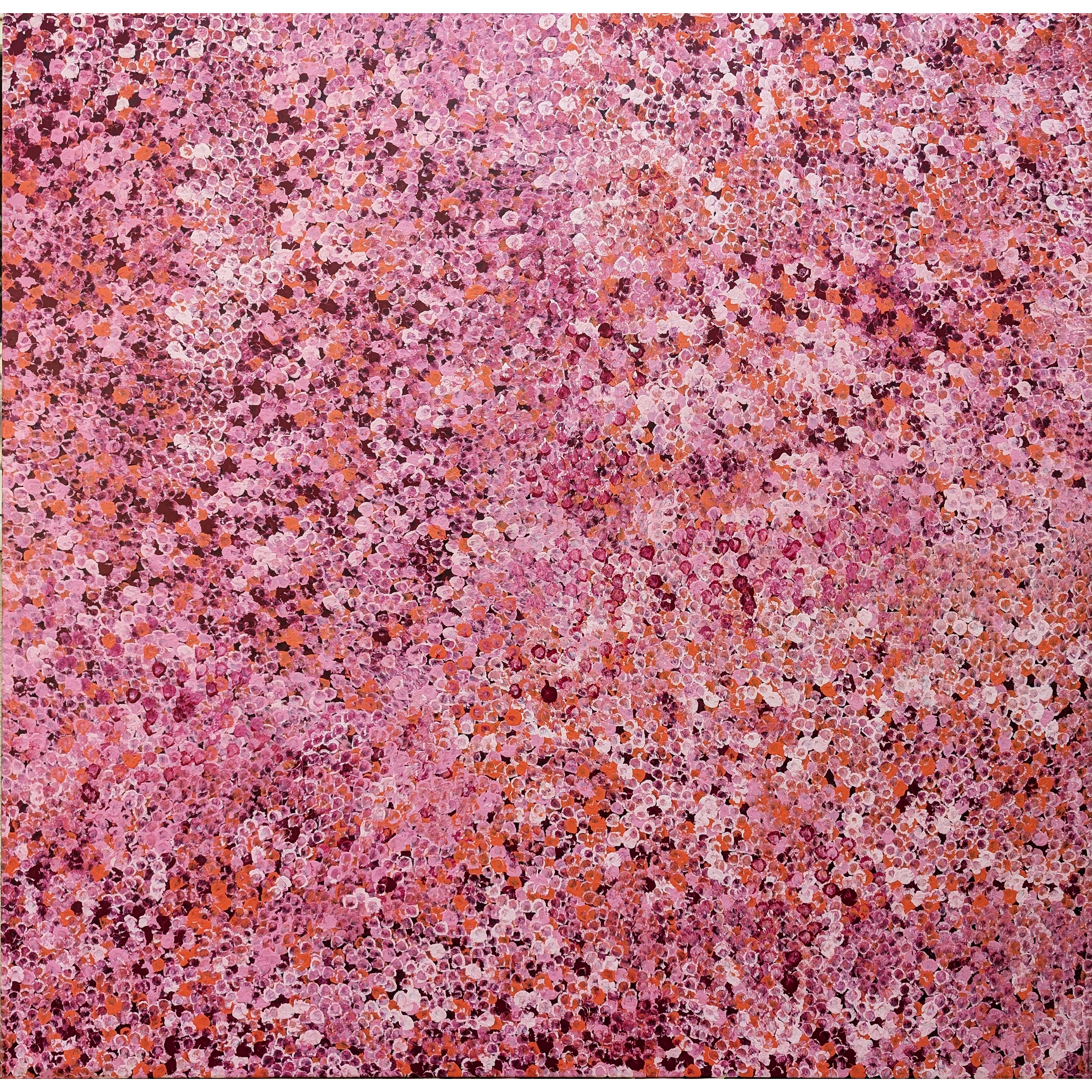
Artist: Lorna Naparrula Fencer | Title: Caterpillar Dreaming | Year: 2002 | Medium: synthetic polymer paint on canvas | Dimensions: 131 x 100
PROVENANCE
Katherine Art Gallery, NT Cat No. P-1074
ARTWORK STORY
This painting tells a story of women heading into the bush collecting bush tucker. The women would travel all day in large groups singing and dancing as they collected food to take back to their large families at the campsite. The women quite often come across a caterpillar that they call the ‘cheeky one’. This is because this particular caterpillar constantly bites the women while they are picking fruit making them quite itchy. These caterpillars are luminous green in colour with bright eyes. In this painting the artist has depicted the home of the caterpillar in the Tanami Desert, NT. The Dreaming track, or songline, runs through the artist’s country and she is one of the most important custodians of the story. The landscape is portrayed as abundant and full of flowers in bloom.
Artist Profile
COMMUNITY/REGION
Lajamanu, NT
LANGUAGE
Warlpiri
BIOGRAPHY
Born c. 1925, at Yarturlu Yarturlu, a Yam Dreaming site, Lorna Fencer, was the custodian of inherited land Yumurrpa situated near Chilla Well, south of the Granites Mine in the Tanami Desert. Her father’s country was Wapurtali. She spent her early years living a traditional life until, in 1949 she, along with many of her Warlpiri countrymen, were forcibly transported to the government settlement of Lajamanu at Hooker Creek, situated in the country of the Gurindji people. Lajamanu lay 250 miles north of the traditional Warlpiri homelands and it became a disconsolate community, as its governance during the 1950’s was militant and suppressive. Many Walrpiri walked the 800 km back to Yuendumu only to be forcibly returned once more, thereby creating a deep sense of disempowerment and loss. Despite this, the Warlpiri elders kept their customs and ceremonies alive with a fierce determination. Lorna Napurrula in particular maintained and strengthened her cultural identity through ceremonial activity thereby asserting her position as a prominent elder and teacher in the community… Continue Reading
PROVENANCE
Katherine Art Gallery, NT Cat No. P-1074
ARTWORK STORY
This painting tells a story of women heading into the bush collecting bush tucker. The women would travel all day in large groups singing and dancing as they collected food to take back to their large families at the campsite. The women quite often come across a caterpillar that they call the ‘cheeky one’. This is because this particular caterpillar constantly bites the women while they are picking fruit making them quite itchy. These caterpillars are luminous green in colour with bright eyes. In this painting the artist has depicted the home of the caterpillar in the Tanami Desert, NT. The Dreaming track, or songline, runs through the artist’s country and she is one of the most important custodians of the story. The landscape is portrayed as abundant and full of flowers in bloom.
Artist Profile
COMMUNITY/REGION
Lajamanu, NT
LANGUAGE
Warlpiri
BIOGRAPHY
Born c. 1925, at Yarturlu Yarturlu, a Yam Dreaming site, Lorna Fencer, was the custodian of inherited land Yumurrpa situated near Chilla Well, south of the Granites Mine in the Tanami Desert. Her father’s country was Wapurtali. She spent her early years living a traditional life until, in 1949 she, along with many of her Warlpiri countrymen, were forcibly transported to the government settlement of Lajamanu at Hooker Creek, situated in the country of the Gurindji people. Lajamanu lay 250 miles north of the traditional Warlpiri homelands and it became a disconsolate community, as its governance during the 1950’s was militant and suppressive. Many Walrpiri walked the 800 km back to Yuendumu only to be forcibly returned once more, thereby creating a deep sense of disempowerment and loss. Despite this, the Warlpiri elders kept their customs and ceremonies alive with a fierce determination. Lorna Napurrula in particular maintained and strengthened her cultural identity through ceremonial activity thereby asserting her position as a prominent elder and teacher in the community… Continue Reading







